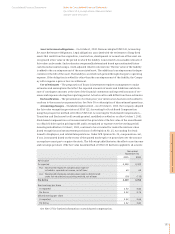Siemens 2005 Annual Report Download - page 150
Download and view the complete annual report
Please find page 150 of the 2005 Siemens annual report below. You can navigate through the pages in the report by either clicking on the pages listed below, or by using the keyword search tool below to find specific information within the annual report.
150
Property, plant and equipment – Property, plant and equipment is valued at acquisition or
manufacturing cost less accumulated depreciation. Depreciation expense is recognized either
using the declining balance method until the straight-line method yields larger expenses or the
straight-line method. As of fiscal 2006, the Company will apply the straight-line method only.
Costs of construction of certain qualifying long-term assets include capitalized interest, which is
amortized over the estimated useful life of the related asset. The following useful lives are
assumed:
Impairment of long-lived assets – The Company reviews long-lived assets held and used for
impairment whenever events or changes in circumstances indicate that the carrying amount of
an asset may not be recoverable. Recoverability of assets to be held and used is measured by the
comparison of the carrying amount of the asset to the undiscounted future net cash flows expect-
ed to be generated by the asset. If such assets are considered to be impaired, the impairment to
be recognized is measured by the amount by which the carrying amount of the assets exceeds the
fair value of the assets. Estimated fair value is generally based on either appraised value or meas-
ured by discounted estimated future cash flows. Long-lived assets to be disposed of by sale are
recorded at the lower of carrying amount or fair value less costs to sell and depreciation is ceased
(see below Accounting changes – Standards implemented for information regarding the adoption
of Statements of Financial Accounting Standards (SFAS) 144.
Derivative instruments and hedging activities – In accordance with SFAS 133, Accounting
for Derivative Instruments and Hedging Activities, as amended, derivative instruments, such as
foreign currency exchange contracts and interest rate swap contracts, are recognized in the
financial statements and measured at fair value regardless of the purpose or intent for holding
them. Changes in the fair value of derivative financial instruments are recognized periodically
either in income or, in the case of a cash flow hedge, in shareholders’ equity (as a component of
other comprehensive income). Certain derivative instruments embedded in host contracts are
also accounted for separately as derivatives. See Note 25, Derivative instruments and hedging
activities, for a description of the Company’s risk management strategies and the effect these
strategies have on the Consolidated Financial Statements.
Taxes – The Company applies SFAS 109, Accounting for Income Taxes. Under the asset and
liability method of SFAS 109, deferred tax assets and liabilities are recognized for the future tax
consequences attributable to differences between the financial statement carrying amounts of
existing assets and liabilities and their respective tax bases. The effect on deferred tax assets and
liabilities of a change in tax laws is recognized in the results of operations in the period the new
laws are enacted. A valuation allowance is recorded to reduce the carrying amounts of deferred
tax assets unless it is more likely than not that such assets will be realized.
Management’s discussion and analysis
Factory and office buildings 20 to 50 years
Other buildings 5 to 10 years
Technical machinery & equipment 5 to 10 years
Furniture & office equipment generally 5 years
Equipment leased to others generally 3 to 5 years
























